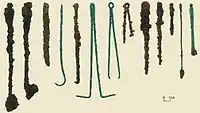Druid of Colchester
The grave of the "Druid of Colchester" was discovered by archaeologists in 1996. The find, at the village of Stanway, Essex, near Colchester, is believed to be that of an Iron Age druid dated c. 40-60 AD. It is among a number of graves of eminent people found, believed to be buried around the time of the Roman invasion of Britain in 43 AD. The area was then associated with the Catuvellauni tribe.[1]

In the wooden chambered burial site, archaeologists uncovered cremated human remains, and a board game — the first time that such a game has been found virtually intact.[2] Other items uncovered included a cloak decorated with brooches, a jet bead believed to have magical properties, medical equipment, a tea strainer still containing some kind of herbal brew, and some mysterious metal poles believed to be used for divining.
This medical kit consisted of 13 instruments including scalpels, sharp and blunt retractors, needles, a probe and surgical saw,[3] hooks and forceps.
A cup was also found, containing traces of the herb mugwort. The tea strainer also contained herbs commonly associated with herbal remedies in ancient times. Philip Crummy, director of the trust, remained cautious, adding that there may be other explanations. "In the report we draw the possibility that this man or woman was a druid," he said. "The so-called druid could have been a doctor. The tea strainer contains artemisia pollen, which is commonly associated with herbal remedies. Healing is an attribute given to druids. We don't know what the metal rods are for, but we think they could have been used for divining. The question is whether all that stacks up to him being a druid. It could be – it was certainly somebody special."
The medical kit was "fairly Romanized" and the individual may have acted "like a Roman surgeon/doctor would have done." "Divination was widely practiced in the Roman world too," he added. Because of the site’s age and location, archaeologist Mike Pitts believed the person was indeed a Celtic Druid and could have been closely related to Cunobelinus, a chief or king of the Catuvellauni tribe.[1]
The Stanway Game
The grave contained a board game, with the glass counters laid out as if in play. Surviving metal corners and hinges from the game board allowed a reconstruction to be created; it is believed to be a 55x40-centimeter (21x15-inch) rectangle[2] with play over a board of 8x12 squares.[4]
The white and blue glass counters, 13 on each side, were ranged against each other, similar to the starting position in chess. All pieces were of equal size except for a single smaller white bead positioned close to the centre of the board.[5]
Given the absence of dice, Dr Irving Finkel, Assistant Keeper of the Ancient Mesopotamia collection in the Middle East department of the British Museum, speculated that the game was one of pure strategy.[1]
A detailed analysis of the game was provided by Ulrich Schädler in 2007.[5] Schädler argues that the game is neither Roman latrunculi nor XII scripta but in fact a relative of the Celtic game known as fidchell or gwyddbwyll. The find suggests the game was played on either 8x12 or 9x13 squares using 13 pieces per side. The presence of just one smaller bead may indicate that the game was asymmetrical, with a king-like piece belonging to one side, as in tafl games.[5]
Alternatively, some people believe this board may have been used along with the metal rods for divining purposes.[6]
In 2015, Colchester resident Alex Jones developed a board game called Aquila[7] inspired by the Stanway game. At least one Aquila tournament was held at the Colchester Roman Circus Centre in September 2015.[7]
References
- Games Britannia - 1. Dicing with Destiny, BBC Four, 1:05am Tuesday 8 December 2009
- The Times; 6 September 1996; Roman board game found at burial site
- The Independent; 22 November 1997; Style & design: Items and Icons treasures
- "Chess Variants: Courier Game".
- Ulrich Schädler (2007). Philip Crummy; S. Benfield; N. Crummy; V. Rigby; D. Shimmin (eds.). "The doctor's game – new light on the history of ancient board games" (PDF). Stanway: An Elite Burial Site at Camulodunum. Britannia Monograph Series. London: Society for the Promotion of Roman Studies. 24: 359–375. Archived from the original on 12 October 2011.
- Andrew Johnson (23 October 2011). "Iron Age Mystery of the Essex Druid". The Independent.
- Zoe Forsey (1 September 2015). "Alex brings game back from the dead". Daily Gazette & Essex County Standard.